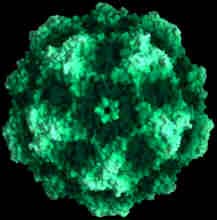

Historical Tales | News | Vampires | Zombies | Werewolves
Virtual Academy | Weapons | Links | Forum
 |
 |
Historical Tales | News | Vampires | Zombies | Werewolves Virtual Academy | Weapons | Links | Forum |
 |
|
The lupine parvovirus magnified 225,000 times |
What distinguishes LPV from other parvoviruses, however, is that it uses the budding method of reproduction and its capsid is much larger in size—though still smaller than the vampire and zombie viruses, as it lacks numerous genes dedicated to cross-species infection.
 |
| LPV's main carrier, the timber wolf |
Wolves transmit the virus to humans through biting, which is why werewolf occurrences closely mirror wolf populations. Unsurprisingly, hunters and fur trappers have always been common victims. There is a growing fear that wolf recovery programs in the United States will result in an increase in werewolves, especially in suburban areas. One saving grace, however, is that LPV cannot infect or be carried in organisms other than canines and primates.
Like vampirism, LPV infects and transforms every living cell in the body that has a nucleus, rather than just infecting and destroying certain tissues. Since it's a DNA virus, unlike the RNA vampire and zombie viruses, no reverse transcription from RNA to DNA is necessary. Upon entering a cell, the viral DNA can immediately integrate itself into the host's chromosomes. Ironically, despite this simpler process, LPV is a much slower-acting virus than even vampirism (likely because the virus doesn't stimulate the thyroid gland as much).
Unfortunately, there is currently no vaccine for LPV. Anyone bitten, or accidentally infected during lab research, is doomed to either transformation or death, with no known cases of natural immunity. There were efforts to create a vaccine before the FVZA was disbanded, but the methods used for the vampire and zombie vaccines fell quite short.
 |
| Sites of Neanderthal and werewolf fossils |
As for a werewolf's lupine visage, it's surely no coincidence considering the virus' more canine host. Lateral gene transfer between wolves and humans is an undoubted possibility.
Lastly, while vampires and zombies came from Africa after plaguing our human ancestors, werewolves were believed to originate in the forest-heavy landmass of Eurasia—possibly after infecting and wiping out our Neanderthal cousins some 40,000 years ago—judging by the discovery of dozens of well-preserved fossils.
 |
|
A severe skin rash is one prominent symptom of early LPV infection, and will persist through most of the transformation. |
A person infected with LPV comes out of the fever in a highly dangerous state, displaying fierce aggression and bloodlust as their communication degrades into grunts, growls and hisses. The victim will make great efforts to flee the company of humans and complete their transformation in a more secluded area, such as a forest, sewer or an abandoned structure.
The physiological transformation into a werewolf begins approximately one week after infection, as the viral DNA essentially takes over the body's process of cellular differentiation—selectively altering certain parts of the human genome based on the final design of the organism. This causes a slow and agonizing reshaping of the victim's bones and soft tissues as the infected cells shift and divide according to their newly-modified genetic instructions.
As with vampirism and zombism, not every victim survives the transformation, as it puts a great deal of strain on the heart and body—especially for the very young, old and ill. The past discoveries of partially-transformed corpses confirm this statement, as well as provide valuable insight into a werewolf's intermediate stages of development.